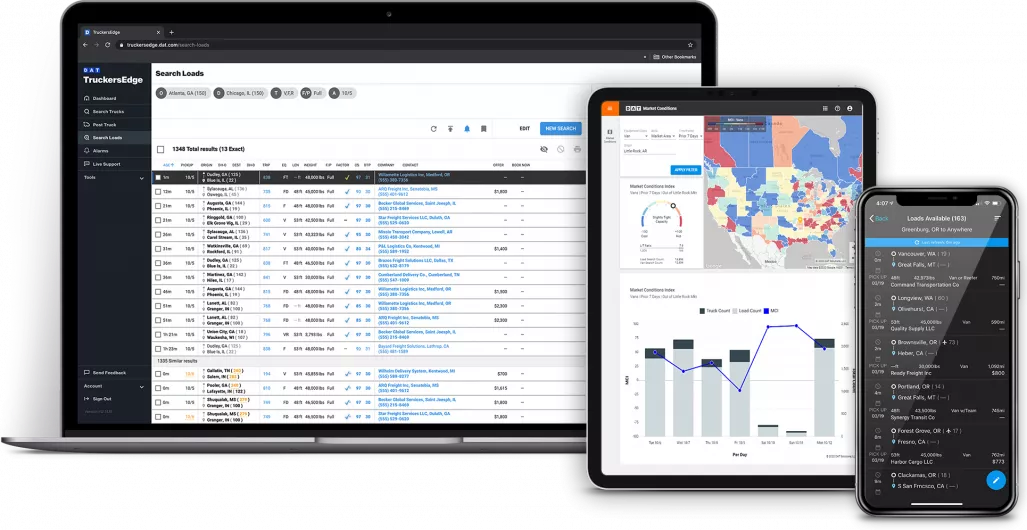Trucking Rates Per Mile
Trucking Rates Per Mile
Stay on top of truck freight rates per mile and keep your profit margins high.
DAT provides the most accurate information about current trucking rates per mile, giving owner operators and carriers the market data they need to negotiate better prices and build solid business relationships.
- View and compare truck freight rates per mile.
- Use powerful freight pricing tools to boost revenue.
- Anticipate market changes before they happen.


View and compare truck freight rates per mile.
When you know how much other carriers and owner operators are making on spot and contract freight, it’s easy to keep your prices competitive.
The DAT One load board platform seamlessly integrates data from the DAT iQ freight rate analytics and forecasting platform to provide you with the most accurate rates-per-mile data in the business. We use billions of dollars in annual carrier payments (not bids or asking prices, but actual invoices) for shipments across all lanes to bring you daily updates to help you make decisions on your van, flatbed, and box truck rates per mile.
Use powerful freight pricing tools to boost revenue.
Deep market insights about changes in trucking rates per mile and regional supply and demand keep unexpected surprises to a minimum.
We collect data from 149 distinct market regions based on zip code instead of geographic radius. The result is the most accurate pricing index in the industry. See market rates for your preferred lanes and freight types in real time, or compare them to historical data from the past 13 months to anticipate seasonal trends with ease. DAT TriHaul also provides triangular routing suggestions to improve your rate per mile.

Anticipate market changes before they happen.
Our tools provide rate forecasting up to 52 weeks in advance with twice the accuracy of any competitor.
Detailed maps of spot market conditions show you where demand and capacity are high, and our rate benchmarking services allow you to make better-informed business decisions and avoid unnecessary pricing risks when planning for the future. DAT iQ’s analysis tools offer customized reports and multi-lane breakdowns for RFP bids that can reveal additional profits you’re not yet claiming.
After factoring in driver pay, insurance premiums, fuel and maintenance costs, permits, tolls, equipment financing, and other expenses, it can be difficult to determine whether your pricing strategy is keeping your rate per mile where it needs to be in order to maintain a proper profit margin. DAT RateView is the best way for brokers, carriers, and shippers to see national and regional freight averages, check on what the competition is doing, and stay ahead of market fluctuations that can impact their bottom line.
To get a flavor for what current rates are, check out the DAT Trendlines free weekly report on national rate and demand trends.
Independent truckers and contractors are responsible for different operational expenses than owner operators — including handling their own authority, permits, annual registration, and taxes — all of which needs to be factored into their prices when they start negotiating with brokers and shippers to keep their rate per mile as competitive as possible.
The good news is that data from DAT iQ’s industry-leading rate database is seamlessly integrated with DAT’s load boards, giving independent truckers real-time access both to available freight listings and the most accurate rate data across all lanes — even if the broker or shipper doesn’t include a price in the listing.
Freight rates are typically influenced by a number of market factors. For example, the COVID-19 pandemic and historically low oil prices were responsible for a significant dropoff in freight volume and market rates in 2020. However, services like rate benchmarking and forecasting help ensure that your rates stay competitive and that you’re able to take advantage of opportunities to increase your revenue as they arise. The DAT blog is another excellent resource for staying up to date on industry trends.
Owner-operators have a set of financial responsibilities, including fixed expenses like truck payments, licensing fees, phone bills, insurance costs, and variable expenses such as fuel purchases, maintenance costs, taxes, and other unexpected charges that come up in the course of delivering freight.
Calculating the annual fixed cost per mile of owning a truck alongside an annual average of variable costs will provide owner operator trucking rates per mile they need to run a profitable business. These can then be compared against their current freight rates, and — using DAT’s analytics and forecasting tools — used to improve pricing strategies for greater profits.
According to the most recent report from the American Transportation Research Institute, operating expenses for motor carriers are on the rise, with the average cost per mile now reaching $1.82. That’s a 7.7 percent hike from the previous year. The advantage of DAT RateView is that it allows you to benchmark prices on your preferred lanes, while also providing data on per-mile accessorial charges and average fuel costs.
With real-time data on trucking rates per mile and analysis of current market conditions, carriers and owner operators are better prepared to negotiate with brokers and shippers. Knowing the right price to ask makes it clear that you’re serious about doing business, which opens up more opportunities for establishing reliable business relationships and better financial management practices.
"In our experience, DAT is the most accurate and complete source of spot and contract rate data available.”
- Don Everhart, VP Technology & Analytics for Knight-Swift Logistics
“By integrating DAT’s forecasting data and analytics tools with our expertise and customized pricing, we can deliver fast, reliable rates using the most comprehensive data and market analysis available.”
- Ryan Ilges, Worldwide Express Vice President of Truckload
See tomorrow's trends today.
Contact us today to get the most trusted truckload pricing tools in trucking and take the uncertainty out of freight. DAT iQ offers the most historically complete freight rate database, so you can anticipate seasonal trends and make quick pricing decisions.